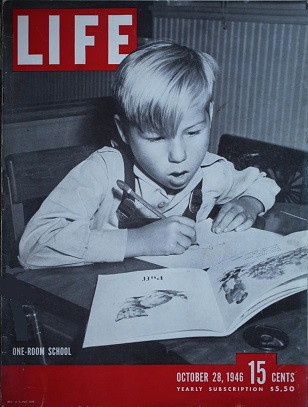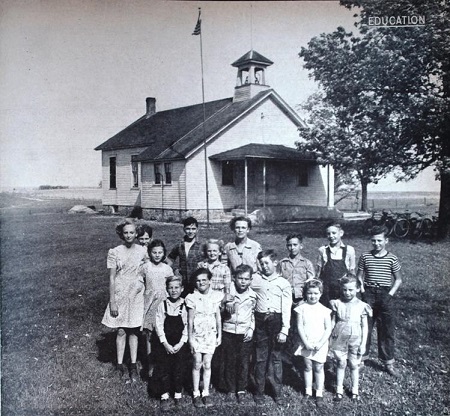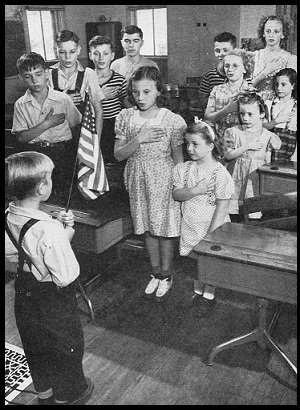|
Life magazine features Pecatonica one-room schoolhouse. |
Olga Gize Carlile is a columnist for The Journal-Standard. |
|
Many people will still remember the excitement
Life Magazine
brought to this area October 1946. That year, a one-room schoolhouse in Pecatonica got top billing in the magazine.
One of the first graders, Charles Buntjer, 6, made the front cover as he laboriously printed “Puff” in his first-grade workbook. Check the last photo of Chuck 60 years later living in San Francisco!
Life Magazine so vividly captured the memory of that day in words and pictures so that 50 years later, we feel as if we were there. Bob Wachlin brought in a copy of the magazine. The first paragraph paints the entire picture for us: “Nancy Fische of the second grade was absent the day the school picture above was taken, but except for her, some playground equipment and two privies which are out of the picture, you are looking at the entire personnel and physical assets of District School 94 near Pecatonica, Ill.” The writer comments that this was “if not the best one-room school in the country, it was certainly one of the best.” They gave credit to the schoolmarm, Miss Erna Meyer, for the 37 years she taught in rural schools, 26 of them in Pecatonica. She was paid about $1,500 a year at that time.
| These one-room schoolteachers were multi-tasking way back then. The magazine describes her teaching day to that of a juggler. Miss Meyer, for example, started the day getting all six grades going n more or less simultaneously.
The seventh graders were given a study problem. The first graders were started crayoning. The second grade was at the blackboard doing arithmetic, while the fifth grade composed a letter. “With the seventh grade studying, the first grade coloring, the second grade figuring, and the fifth grade writing, Erna has time to check homework with the third grade, after assigning some grading in geography to the sixth grade.” “With the seventh grade studying, the first grade coloring, the second grade figuring, and the fifth grade writing, Erna has time to check homework with the third grade, after assigning some grading in geography to the sixth grade.” “With all of this going on each day, she also was expected to plan study courses, order books and supplies, give special attention to pupils who needed it, and to keep an eye on the schoolhouse roof to see that it doesn’t spring a leak.” That was indeed multi-tasking and here we thought we invented it in the year 2000. There’s a great deal of history of one-room schoolhouses in this area at the Stephenson County Historical Museum, as well as a one-room schoolhouse on the grounds. Teachers who taught in one-room schoolhouses found that their students learned the basics very well. What they might have missed in the third and fourth grade, they later heard and picked up on in the later grades as they listened to other classes.
|
These teachers also kept the fire going in the pot-bellied stove, swept the floors and cleaned the blackboards n or had some help from the students in a few of these tasks. One Stephenson County schoolmarm once told me she had her students bring a potato to school, which she would place on the stove, to cook a “hot lunch” at noon. The October day at the Pecatonica School in the photo essay shows the students at their desks. The next photo shows them reciting the Pledge of Allegiance. In the next row of pictures, the first graders are sending a letter to Mr. Puff, students at the blackboard doing simple sums, students listening to a lecture and then a reading session with students and the last on that page of a boy discussing his blackboard composition.
On the final page of the essay, we see young Homer Meiers, a seventh grader on a bicycle, then three second graders carrying their lunches to school, and seventh grade twins, Kenneth and Keith Fische, on a horse. The magazine’s photo essay on the one-room schoolhouse concludes with a large photo showing recess at the school. The first two grades are given a 15-minute break. After this, classes resumed until noon and had a one-hour lunch break. The youngest students go home at 3:30 p.m.; the older ones at 4 p.m. Then the teacher, corrects papers and goes home around 5 p.m. What a wonderful legacy these teachers left behind. Stories of one-room schoolhouse teachers may be found that the Stephenson County Historical Museum. In the days of readin’, writin’ and ’rithmetic, they got their lessons for life.
|
|
San Francisco California |

|
Created on: 2015.10.10
Updated on: 2015.10.10 |


